A Participatory Approach to Evaluating Strategies for Forest Carbon Mitigation in British Columbia
Abstract
:1. Introduction
- What main objectives do stakeholders and Indigenous Peoples prioritize when discussing carbon mitigation in BC’s forest sector?
- What are BC’s stakeholders and Indigenous Peoples’ preferences for, and perceived acceptability, credibility, and effectiveness of, climate change mitigation options in BC’s forest sector?
2. Forest Carbon Management in British Columbia
3. Methods
3.1. Analytic-Deliberative Processes
- Clarification of the decision context: The main objective is to identify the problem or question being addressed and who should be involved in the process.
- Structuring of the decision problem: This step involves the identification of evaluation criteria (also termed values, objectives, or points of view) with which the alternatives will be assessed.
- Identification and outline of alternatives: The objective of this phase is to produce and describe a set of alternatives that can be evaluated and compared by the participants.
- Elicitation of preferences: The goal of this step is to elicit participants’ preferences, that is the evaluation of the importance of the criteria and alternatives.
- Trade-offs among alternatives: In this final step, the preferences or weightings elicited both for criteria and alternatives are pooled together to rank the alternatives and highlight trade-offs.
3.2. Data Collection
3.2.1. Stakeholder Analysis
3.2.2. First Series of Participatory Workshops: Objective Identification
3.2.3. Second Series of Workshops: Evaluation of Mitigation Strategies
3.3. Data Analysis
4. Results and Discussion
4.1. Final Aggregated List of Objectives and Their Relative Importance
4.2. Evaluation of the Six Mitigation Strategies
4.2.1. Group Evaluation: Performance of the Strategies against the Objectives
Bioenergy
Higher Utilization
Longer-Lived Wood Products (LLWP)
Reduced Harvest
Old Growth Conservation
Rehabilitation
4.2.2. Individual Support for Strategies: Regional and Sectoral Variations
5. Conclusions
Supplementary Materials
Acknowledgments
Author Contributions
Conflicts of Interest
References
- IPCC. Climate Change 2014: Mitigation of Climate Change. Contribution of Working Group III to the Fifth Assessment Report of the Intergovernmental Panel on Climate Change; Cambridge University Press: Cambridge, UK; New York, NY, USA, 2014. [Google Scholar]
- Food and Agriculture Organization of the United Nations (FAO). Forestry for a Low-Carbon Future: Integrating Forests and Wood Products in Climate Change Strategies; Fao Forestry Paper 117; FAO: Rome, Italy, 2016. [Google Scholar]
- BC MFLNRO (Ministry of Forests, Lands and Natural Resource Operation). Our Natural Advantage: Forest Sector Strategy for British Columbia; Government of British Columbia: Victoria, BC, Canada, 2012.
- Government of British Columbia. British Columbia’s Climate Leadership Plan; Government of British Columbia: Victoria, BC, Canada, 2016.
- BC MFLNRO. Climate Mitigation Potential of British Columbian Forests: Growing Carbon Sinks; Government of British Columbia: Victoria, BC, Canada, 2013.
- Hoberg, G.; Peterson St-Laurent, G.; Schittecatte, G.; Dymond, C.C. Forest carbon mitigation policy: A policy gap analysis for British Columbia. For. Policy Econ. 2016, 69, 73–82. [Google Scholar] [CrossRef]
- Peterson St-Laurent, G.; Hagerman, S.; Hoberg, G. Emergence and influence of a new policy regime: The case of forest carbon offsets in British Columbia. Land Use Policy 2017, 60, 169–180. [Google Scholar] [CrossRef]
- Peterson St-Laurent, G.; Hagerman, S.; Hoberg, G. Barriers to the development of forest carbon offsetting: Lessons from British Columbia, Canada. J. Environ. Manag. 2017, 203, 208–217. [Google Scholar] [CrossRef] [PubMed]
- Forest Enhancement Society of BC. $150-Million Reforestation Investment Will Help Fight Climate Change, Create More Rural Jobs. Available online: http://www.fesbc.ca/reforestation-investment.html (accessed on 23 January 2018).
- Howlett, M.; Rayner, J.; Tollefson, C. From Old to New Dynamics in Canadian Forest Policy: Dynamics whithout Change? 3rd ed.; Boardman, R., VanNijnatten, D.L., Eds.; Oxford University Press: Don Mills, ON, Canada, 2009; pp. 183–196. [Google Scholar]
- Diaz-Balteiro, L.; Romero, C. Making forestry decisions with multiple criteria: A review and an assessment. For. Ecol. Manag. 2008, 255, 3222–3241. [Google Scholar] [CrossRef]
- Sheppard, S.R.J.; Meitner, M. Using multi-criteria analysis and visualisation for sustainable forest management planning with stakeholder groups. For. Ecol. Manag. 2005, 207, 171–187. [Google Scholar] [CrossRef]
- Natural Resource Council (NRC). Understanding Risk: Informing Decisions in a Democratic Society; National Academy Press: Washington, DC, USA, 1996. [Google Scholar]
- Cullen, D.; McGee, G.J.A.; Gunton, T.I.; Day, J.C. Collaborative planning in complex stakeholder environments: An evaluation of a two-tiered collaborative planning model. Soc. Nat. Resour. 2010, 23, 332–350. [Google Scholar] [CrossRef]
- Tindall, D.B.; Trosper, R.; Perreault, P. Aboriginal Peoples and Forest Lands in Canada; UBC Press: Vancouver, BC, Canada, 2013. [Google Scholar]
- BC MOE. British Columbia Greenhouse Gas Inventory. Available online: http://www2.gov.bc.ca/gov/content/environment/climate-change/reports-data/provincial-ghg-inventory (accessed on 31 August 2017).
- Kurz, W.A.; Dymond, C.C.; Stinson, G.; Rampley, G.J.; Neilson, E.T.; Carroll, A.L.; Ebata, T.; Safranyik, L. Mountain pine beetle and forest carbon feedback to climate change. Nature 2008, 452, 987–990. [Google Scholar] [CrossRef] [PubMed]
- Kurz, W.A.; Smyth, C.E.; Lemprière, T.C. Climate change mitigation through forest sector activities: Principles, potential and priorities. Unasylva 2016, 246, 61–67. [Google Scholar]
- Lemprière, T.C.; Kurz, W.A.; Hogg, E.H.; Schmoll, C.; Rampley, G.J.; Yemshanov, D.; McKenney, D.W.; Gilsenan, R.; Beatch, A.; Blain, D.; et al. Canadian boreal forests and climate change mitigation. Environ. Rev. 2013, 21, 293–321. [Google Scholar] [CrossRef]
- Nabuurs, G.J.; Masera, O.; Andrasko, K.; Benitez-Ponce, P.; Boer, R.; Dutschke, M.; Elsiddig, E.; Ford-Robertson, J.; Frumhoff, P.; Karjalainen, T.; et al. Forestry. In Climate Change 2007: Mitigation. Contribution of Working Group III to the Fourth Assessment Report of the IPCC; Metz, B., Davidson, O.R., Bosch, P.R., Dave, R., Meyer, L.A., Eds.; Cambridge University Press: Cambridge, UK; New York, NY, USA, 2007; pp. 541–584. [Google Scholar]
- Smyth, C.; Rampley, G.; Lemprière, T.C.; Schwab, O.; Kurz, W.A. Estimating product and energy substitution benefits in national-scale mitigation analyses for Canada. GCB Bioenergy 2016, 9, 1071–1084. [Google Scholar] [CrossRef]
- Jasanoff, S. Technologies of humility: Citizen participation in governing science. Minerva 2003, 41, 223–244. [Google Scholar] [CrossRef]
- Petts, J.; Brooks, C. Expert conceptualisations of the role of lay knowledge in environmental decisionmaking: Challenges for deliberative democracy. Environ. Plan. A 2006, 38, 1045–1059. [Google Scholar] [CrossRef]
- Garmendia, E.; Gamboa, G. Weighting social preferences in participatory multi-criteria evaluations: A case study on sustainable natural resource management. Ecol. Econ. 2012, 84, 110–120. [Google Scholar] [CrossRef]
- Renn, O. A model for an analytic-deliberative process in risk management. Environ. Sci. Technol. 1999, 33, 3049–3055. [Google Scholar] [CrossRef]
- Burgess, J.; Stirling, A.; Clark, J.; Davies, G.; Eames, M.; Staley, K.; Williamson, S. Deliberative mapping: A novel analytic-deliberative methodology to support contested science-policy decisions. Public Underst. Sci. 2007, 16, 299–322. [Google Scholar] [CrossRef]
- Mendoza, G.A.; Martins, H. Multi-criteria decision analysis in natural resource management: A critical review of methods and new modelling paradigms. For. Ecol. Manag. 2006, 230, 1–22. [Google Scholar] [CrossRef]
- Sheppard, S.R. Participatory decision support for sustainable forest management: A framework for planning with local communities at the landscape level in Canada. Can. J. For. Res. 2005, 35, 1515–1526. [Google Scholar] [CrossRef]
- Gregory, R.; Failing, L.; Harstone, M.; Long, G.; McDaniels, T.; Ohlson, D. Structured Decision Making; John Wiley & Sons, Ltd.: Chichester, UK, 2012. [Google Scholar]
- Failing, L.; Gregory, R.; Higgins, P. Science, uncertainty, and values in ecological restoration: A case study in structured decision-making and adaptive management. Restor. Ecol. 2013, 21, 422–430. [Google Scholar] [CrossRef]
- Ohlson, D.W.; McKinnon, G.A.; Hirsch, K.G. A structured decision-making approach to climate change adaptation in the forest sector. For. Chron. 2005, 81, 97–103. [Google Scholar] [CrossRef]
- Carlson, M.; Chen, J.; Elgie, S.; Henschel, C. Maintaining the role of Canada’s forests and peatlands in climate regulation. For. Chron. 2010, 86, 434–443. [Google Scholar] [CrossRef]
- Stinson, G.; Freedman, B. Potential for carbon sequestration in canadian forests and agroecosystems. Mitig. Adapt. Strateg. Glob. Chang. 2001, 6, 1–23. [Google Scholar] [CrossRef]
- Grimble, R.; Wellard, K. Stakeholder methodologies in natural resource management: A review of principles, contexts, experiences and opportunities. Agric. Syst. 1997, 55, 173–193. [Google Scholar] [CrossRef]
- Harrison, S.R.; Qureshi, M.E. Choice of stakeholder groups and members in multicriteria decision models. Nat. Resour. Forum 2000, 24, 11–19. [Google Scholar] [CrossRef]
- Herath, G. Incorporating community objectives in improved wetland management: The use of the analytic hierarchy process. J. Environ. Manag. 2004, 70, 263–273. [Google Scholar] [CrossRef] [PubMed]
- Xu, Z.; Smyth, C.E.; Lemprière, T.C.; Rampley, G.J.; Kurz, W.A. Climate change mitigation strategies in the forest sector: Biophysical impacts and economic implications in British Columbia, Canada. Mitig. Adapt. Strateg. Glob. Chang. 2018, 23, 257–290. [Google Scholar] [CrossRef]
- Peterson St-Laurent, G.; Hoberg, G.; Kurz, W.A.; Lemprière, T.C.; Smyth, C.E.; Xu, Z. Evaluating Options for Managing British Columbia’s Forest Sector to Mitigate Climate Change; Pacific Institute for Climate Solutions: Victoria, BC, Canada, 2017. [Google Scholar]
- Barfod, M.B.; Leleur, S. Multi-Criteria Decision Analysis for Use in Transport Decision Making; Technical University of Denmark: Kgs Lyngby, Denmark, 2014. [Google Scholar]
- Kajanus, M.; Kangas, J.; Kurttila, M. The use of value focused thinking and the A’WOT hybrid method in tourism management. Tour. Manag. 2004, 25, 499–506. [Google Scholar] [CrossRef]
- Reynolds, K.M. Prioritizing salmon habitat restoration with the ahp, smart, and uncertain data. In The Analytic Hierarchy Process in Natural Resource and Environmental Decision Making; Springer: Dordrecht, The Netherlands, 2001; Volume 3, pp. 199–217. [Google Scholar]
- Kangas, J.; Kangas, A. Multiple criteria decision support in forest management—The approach, methods applied, and experiences gained. For. Ecol. Manag. 2005, 207, 133–143. [Google Scholar] [CrossRef]
- Stagl, S. Multicriteria evaluation and public participation: The case of uk energy policy. Land Use Policy 2006, 23, 53–62. [Google Scholar] [CrossRef]
- Waeber, P.O.; Nitschke, C.R.; Le Ferrec, A.; Harshaw, H.W.; Innes, J.L. Evaluating alternative forest management strategies for the champagne and aishihik traditional territory, southwest yukon. J. Environ. Manag. 2013, 120, 148–156. [Google Scholar] [CrossRef] [PubMed]
- Kozak, R.A.; Spetic, W.C.; Harshaw, H.W.; Maness, T.C.; Sheppard, S.R.J. Public priorities for sustainable forest management in six forest dependent communities of British Columbia. Can. J. For. Res. 2008, 38, 3071–3084. [Google Scholar] [CrossRef]
- The Montréal Process. The Montréal Process: Criteria and Indicators for the Conservation and Sustainable Management of Temperate and Boreal Forests. Available online: https://www.montrealprocess.org/Resources/Criteria_and_Indicators/index.shtml (accessed on 28 June 2017).
- Prabhu, R.; Colfer, C.J.P.; Dudley, R.G. Guidelines for Developing, Testing and Selecting Criteria and Indicators for Sustainable Forest Management: A C&I Developer’s Reference; CIFOR: Jakarta, Indonesia, 1999; Volume 1. [Google Scholar]
- Forest Stewardship Council. FSC Principles and Criteria: International Guidelines Developed through Consensus. Available online: https://ca.fsc.org/en-ca/fsc-certification/forest-management-certification/principles-criteria (accessed on 28 June 2017).
- Tindall, D.B.; Harshaw, H.W.; Sheppard, S.R.J. Understanding the social bases of satisfaction with public participation in forest management decision-making in British Columbia. For. Chron. 2010, 86, 709–722. [Google Scholar] [CrossRef]
- Harshaw, H.W.; Sheppard, S.R.J.; Jeakins, P. Public attitudes toward sustainable forest management: Opinions from forest-dependent communities in British Columbia. BC J. Ecosyst. Manag. 2009, 10, 81–103. [Google Scholar]
- Freedman, B.; Stinson, G.; Lacoul, P. Carbon credits and the conservation of natural areas. Environ. Rev. 2009, 17, 1–19. [Google Scholar] [CrossRef]
- Simonet, G.; Delacote, P.; Robert, N. On managing co-benefits in REDD+ projects. Int. J. Agric. Resour. Gov. Ecol. 2016, 12, 170. [Google Scholar] [CrossRef]
- Lippke, B.; Oneil, E.; Harrison, R.; Skog, K.; Gustavsson, L.; Sathre, R. Life cycle impacts of forest management and wood utilization on carbon mitigation: Knowns and unknowns. Carbon Manag. 2011, 2, 303–333. [Google Scholar] [CrossRef]
- Blanco, J.A.; Flanders, D.; Littlejohn, D.; Robinson, P.; Dubois, D. Fire in the Woods or RE in the Boiler? A New Tool to Help Rural Communities Determine If Forest Biomass from Wild RE Abatement Can Sustainably Fuel a District Heating System; Pacific Institute for Climate Solutions: Victoria, BC, Canada, 2013. [Google Scholar]
- Miner, R.A.; Abt, R.C.; Bowyer, J.L.; Buford, M.A.; Malmsheimer, R.W.; O’Laughlin, J.; Oneil, E.E.; Sedjo, R.A.; Skog, K.E. Forest carbon accounting considerations in us bioenergy policy. J. For. 2014, 112, 591–606. [Google Scholar]
- Smyth, C.E.; Stinson, G.; Neilson, E. Quantifying the biophysical climate change mitigation potential of Canada’s forest sector. Biogeosciences 2014, 11, 3515–3529. [Google Scholar] [CrossRef]
- McKechnie, J.; Colombo, S.; Chen, J.; Mabee, W.; MacLean, H.L. Forest bioenergy or forest carbon? Assessing trade-offs in greenhouse gas mitigation with wood-based fuels. Environ. Sci. Technol. 2011, 45, 789–795. [Google Scholar] [PubMed]
- Smyth, C.; Kurz, W.A.; Rampley, G.; Lemprière, T.C.; Schwab, O. Climate change mitigation potential of local use of harvest residues for bioenergy in Canada. GCB Bioenergy 2016, 9, 817–832. [Google Scholar] [CrossRef]
- Greig, M.; Bull, G. Carbon Management in British Columbia’s Forests: Opportunities and Challenges; Forrex Series 24; Forum for Research and Extension in Natural Resources Society (FOREX): Kamloops, BC, Canada, 2008. [Google Scholar]
- Lippke, B.; Wilson, J.; Meil, J.; Taylor, A. Characterizing the importance of carbon stored in wood products. Wood Fiber Sci. 2010, 42, 5–14. [Google Scholar]
- Gan, J.; McCarl, B.A. Measuring transnational leakage of forest conservation. Ecol. Econ. 2007, 64, 423–432. [Google Scholar] [CrossRef]
- ONeill, G.; Wang, T.; Ukrainetz, N.; Charleson, L.; McAuley, L.; Yanchuk, A.; Zedel, S. A Proposed Climate-Based Seed Transfer System for British Columbia; B.C. Tech. Rep. 099; Government of British Columbia: Victoria, BC, Canada, 2017. [Google Scholar]
- Park, A.; Talbot, C. Assisted migration: Uncertainty, risk and opportunity. For. Chron. 2012, 88, 412–419. [Google Scholar] [CrossRef]
- Parker, C.; Merger, E.; Streck, C.; Conway, D.; Tennigkeit, T.; Wilkes, A. The Land-Use Sector within the Post-2020 Climate Regime; Norden: Copenhagen, Denmark, 2014. [Google Scholar]
- Kurz, W.A.; Stinson, G.; Rampley, G.J.; Dymond, C.C.; Neilson, E.T. Risk of natural disturbances makes future contribution of Canada’s forests to the global carbon cycle highly uncertain. Proc. Natl. Acad. Sci. USA 2008, 105, 1551–1555. [Google Scholar] [CrossRef] [PubMed]
- Swift, K.; Ran, S. Successional responses to natural disturbance, forest management, and climate change in British Columbia’s forests. BC J. Ecosyst. Manag. 2012, 13, 1–23. [Google Scholar]
- Parfitt, B. Managing BC’s Forests for a Cooler Planet: Carbon Storage, Sustainable Jobs and Conservation; Canadian Centre for Policy Alternatives: Vancouver, BC, Canada, 2010. [Google Scholar]
- Kurz, W.A.; Shaw, C.H.; Boisvenue, C.; Stinson, G.; Metsaranta, J.; Leckie, D.; Dyk, A.; Smyth, C.; Neilson, E.T. Carbon in Canada’s boreal forest—A synthesis. Environ. Rev. 2013, 21, 260–292. [Google Scholar] [CrossRef]
- Pralle, S. Branching out, Digging in: Environmental Advocacy and Agenda-Setting; Georgetown University Press: Washington, DC, USA, 2006. [Google Scholar]
- Cashore, B.; Hoberg, G.; Howlett, M.; Rayner, J.; Wilson, J. In Search of Sustainability: British Columbia Forest Policy in the 1990s; UBC Press: Vancouver, BC, Canada, 2001; p. 340. [Google Scholar]
- BC MFLNRO. Discussion Paper: Area-Based Forest Tenures; Government of British Columbia: Victoria, BC, Canada, 2014.
- Price, K.; Roburn, A.; MacKinnon, A. Ecosystem-based management in the great bear rainforest. For. Ecol. Manag. 2009, 258, 495–503. [Google Scholar] [CrossRef]
- Taylor, S.W.; Carrol, A.L.; Alfaro, R.I.; Safranyik, L. Forest, Climate and Moutain Pine Beetle Outbreak Dynamics in Western Canada; Safranyik, L., Wilson, B., Eds.; Natural Resource Canada: Victoria, BC, Canada, 2006; pp. 67–94. [Google Scholar]
- Lundmark, T.; Bergh, J.; Hofer, P.; Lundström, A.; Nordin, A.; Poudel, B.; Sathre, R.; Taverna, R.; Werner, F. Potential roles of swedish forestry in the context of climate change mitigation. Forests 2014, 5, 557–578. [Google Scholar] [CrossRef]
- Malmsheimer, R.W.; Bowyer, J.L.; Fried, J.S.; Gee, E.; Izlar, R.L.; Miner, R.A.; Munn, I.A.; Oneil, E.; Stewart, W.C. Managing forests because carbon matters: Integrating energy, products, and land management policy. J. For. 2011, 109, S7–S51. [Google Scholar]

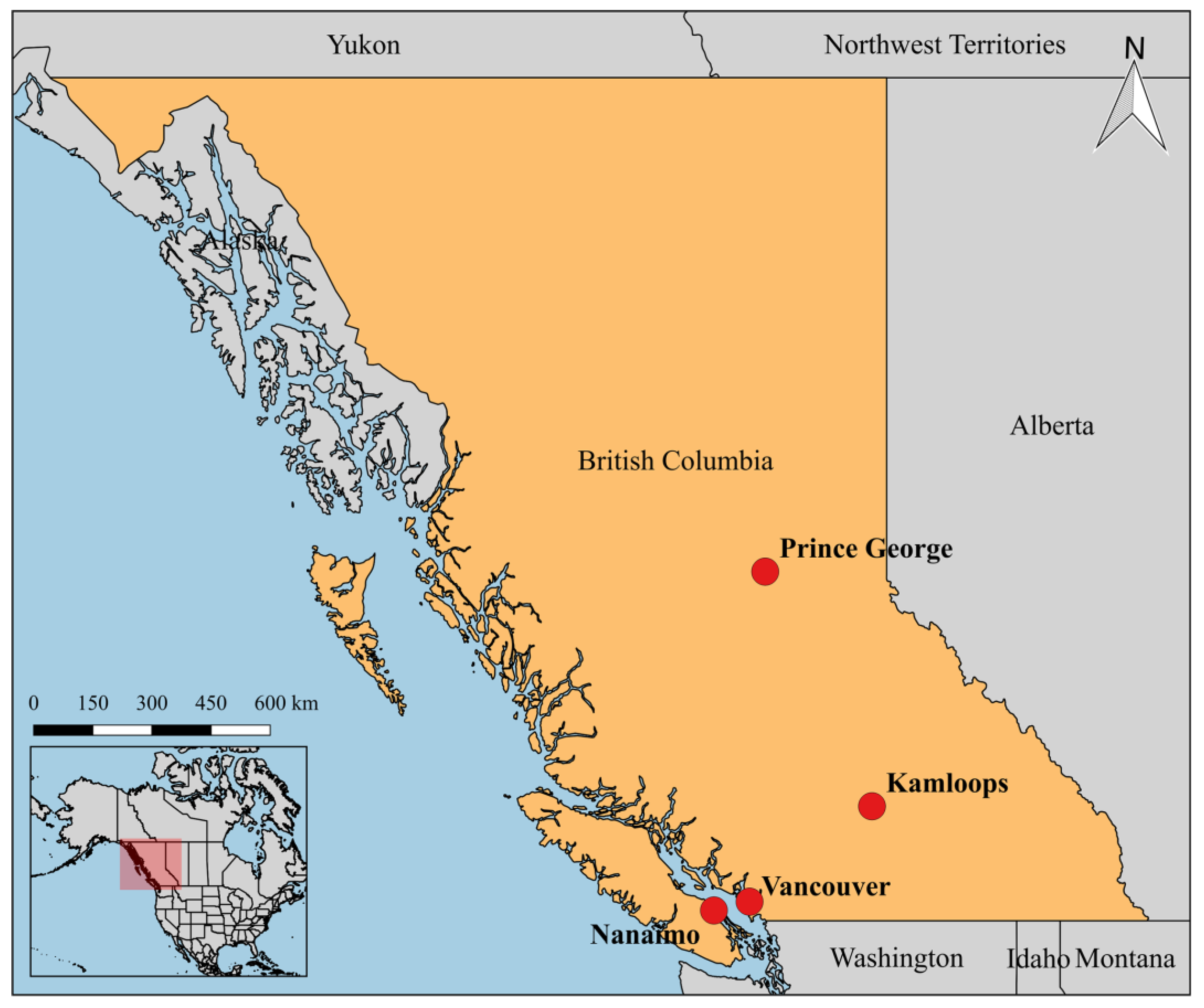
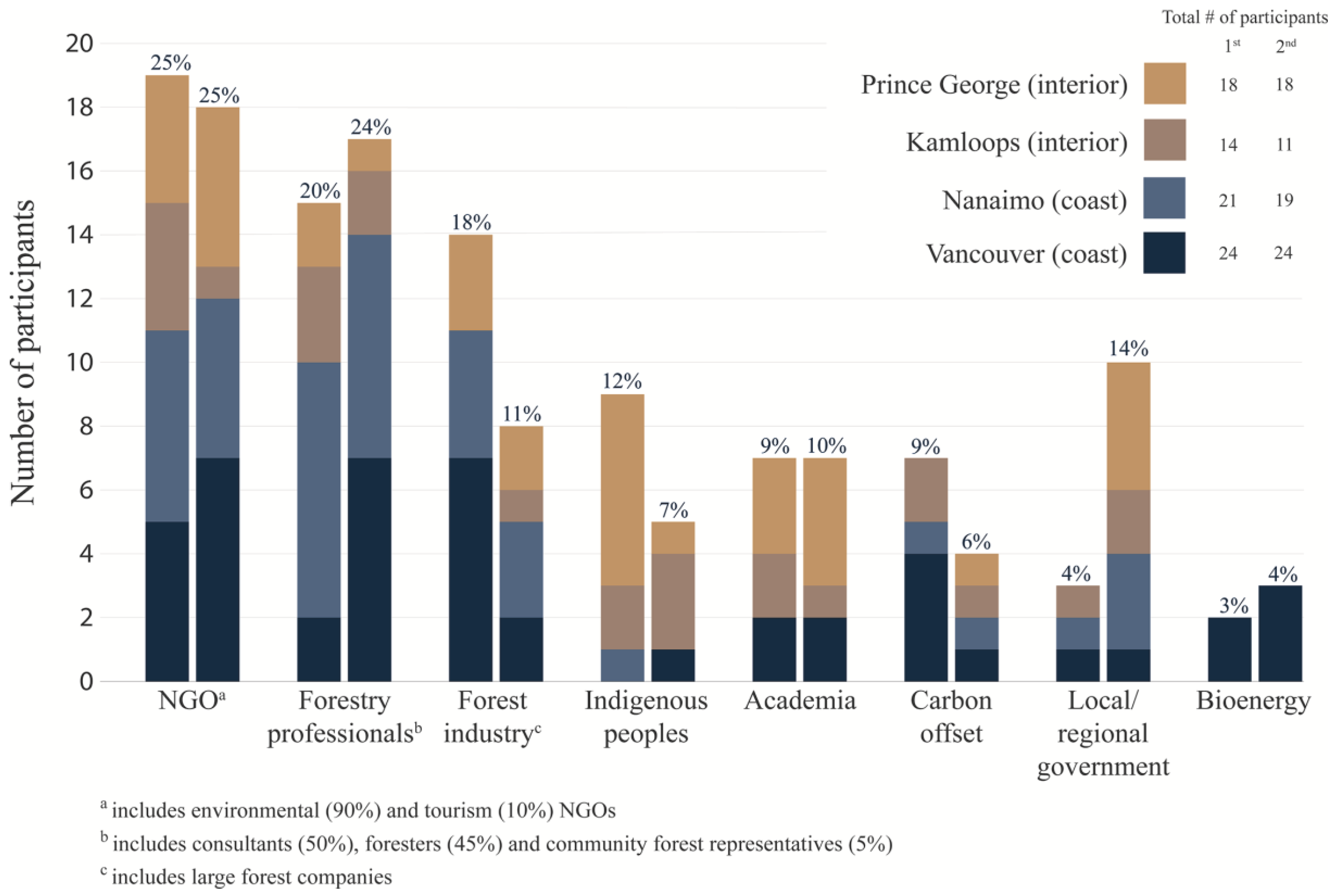
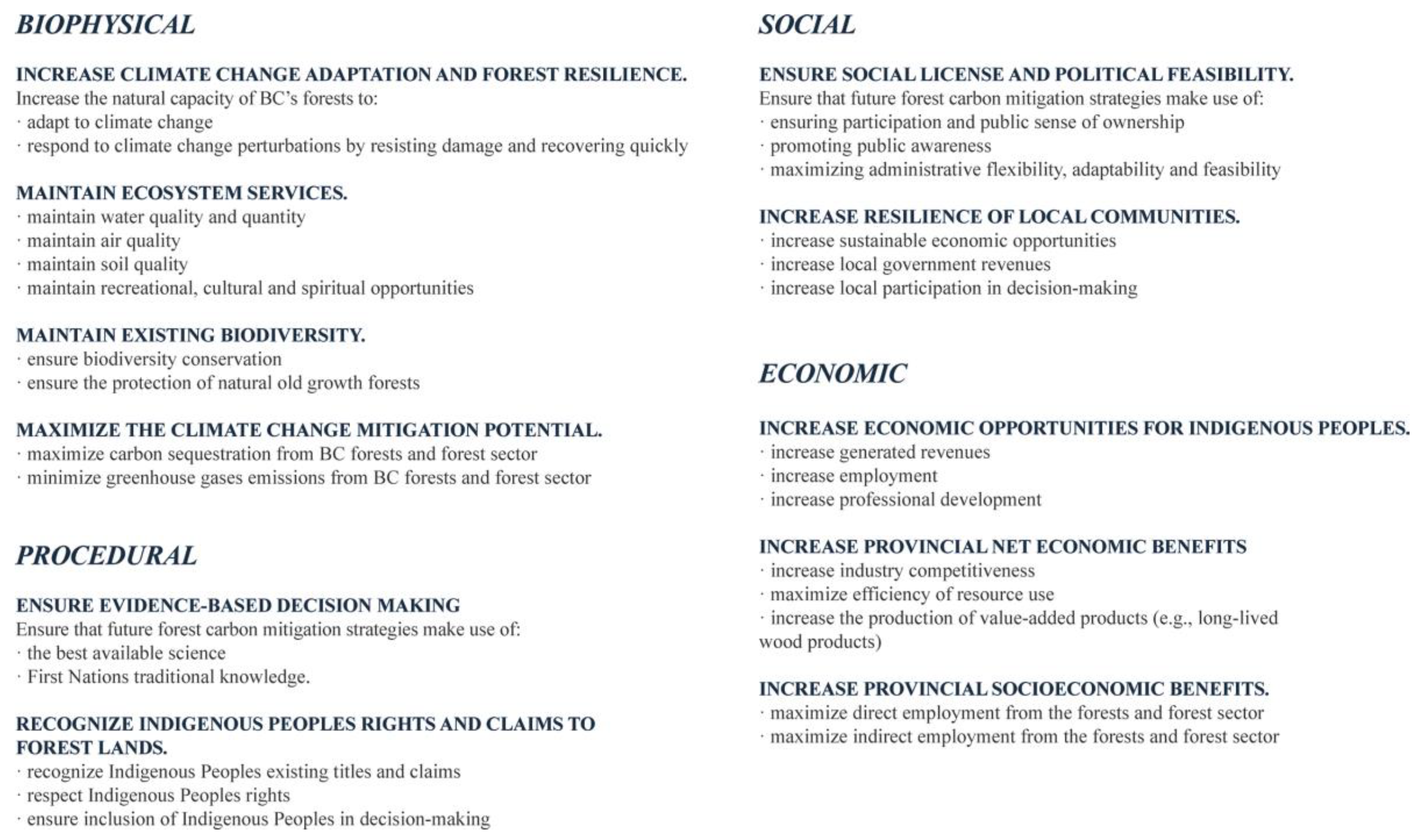
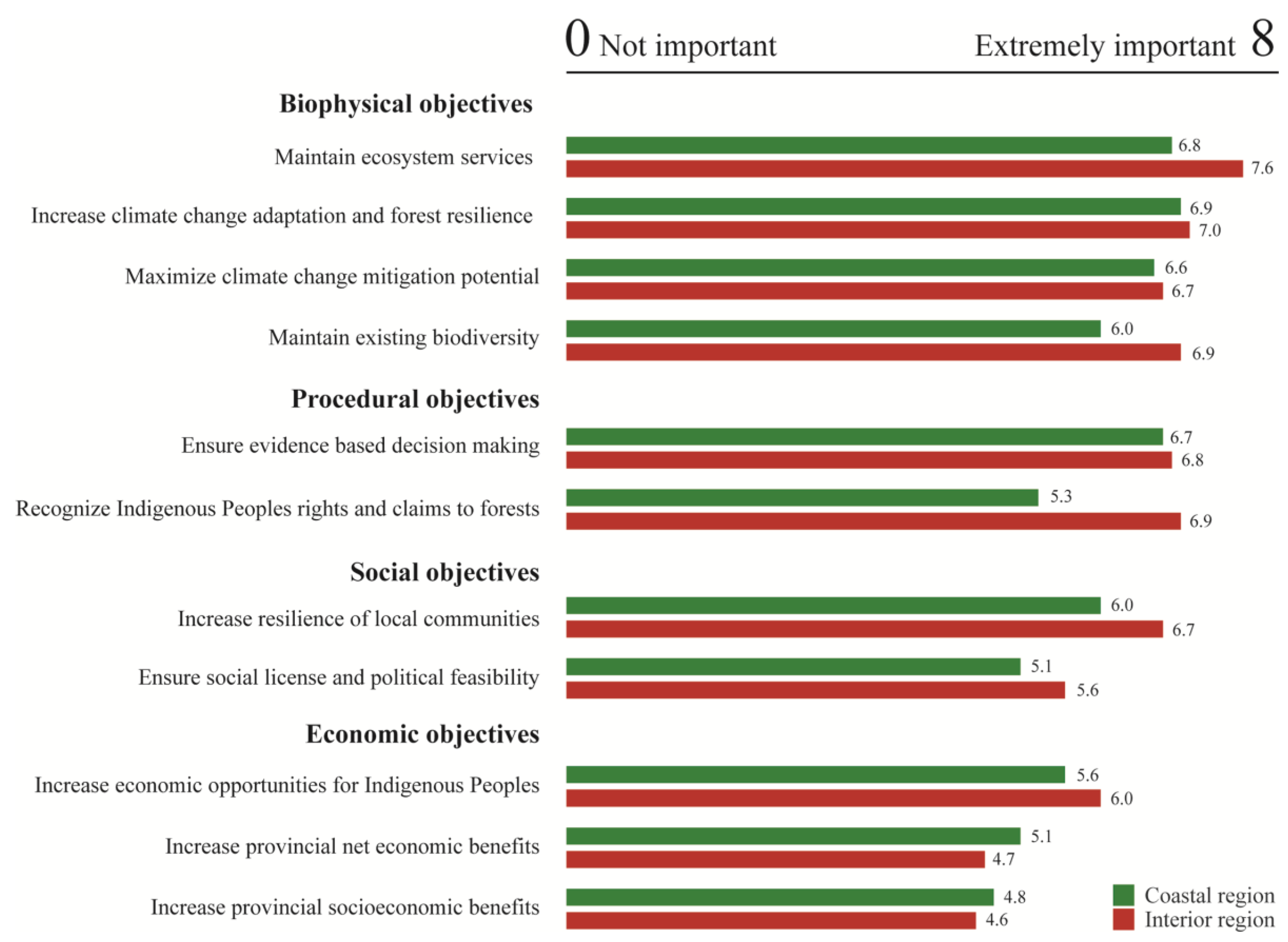
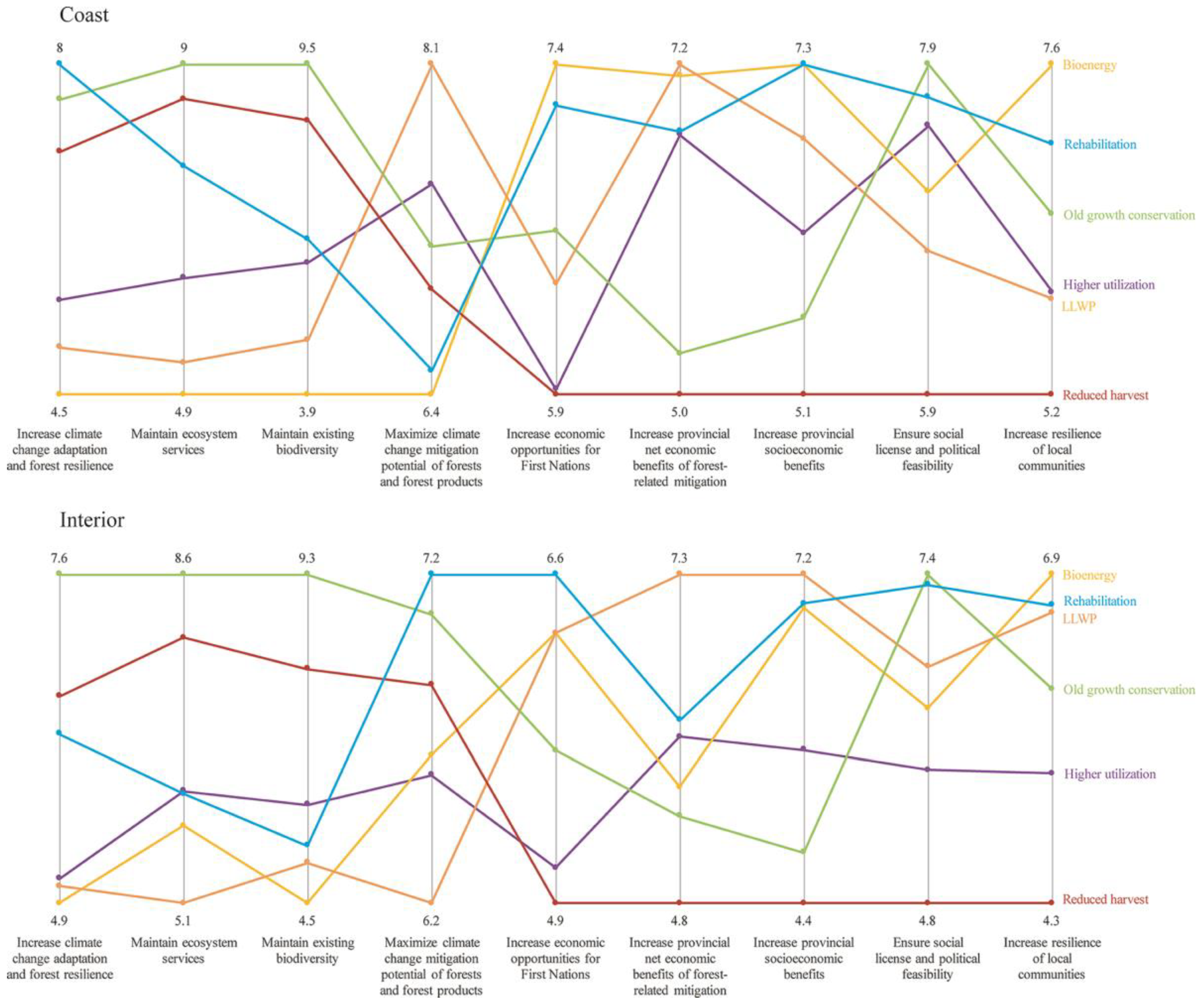
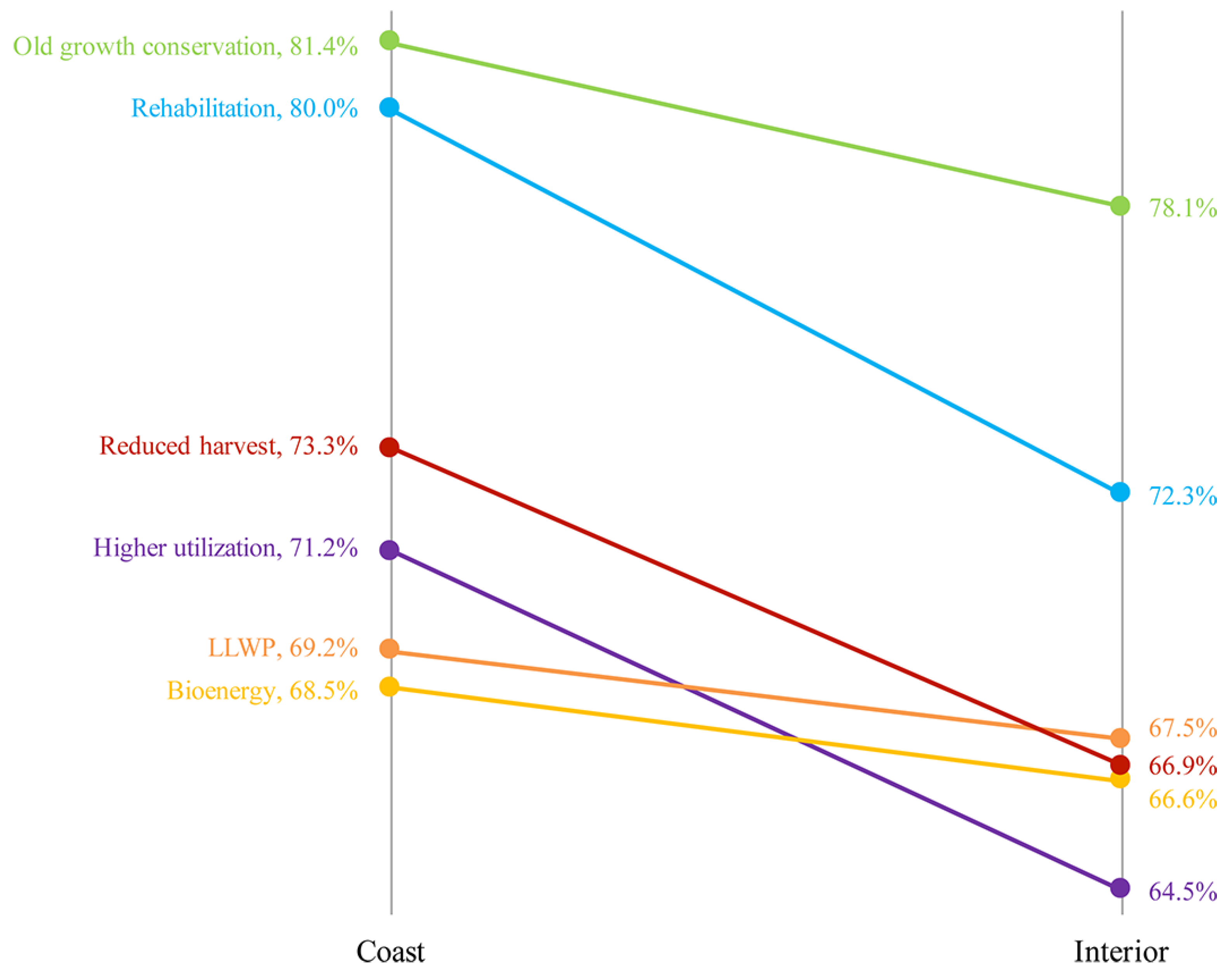
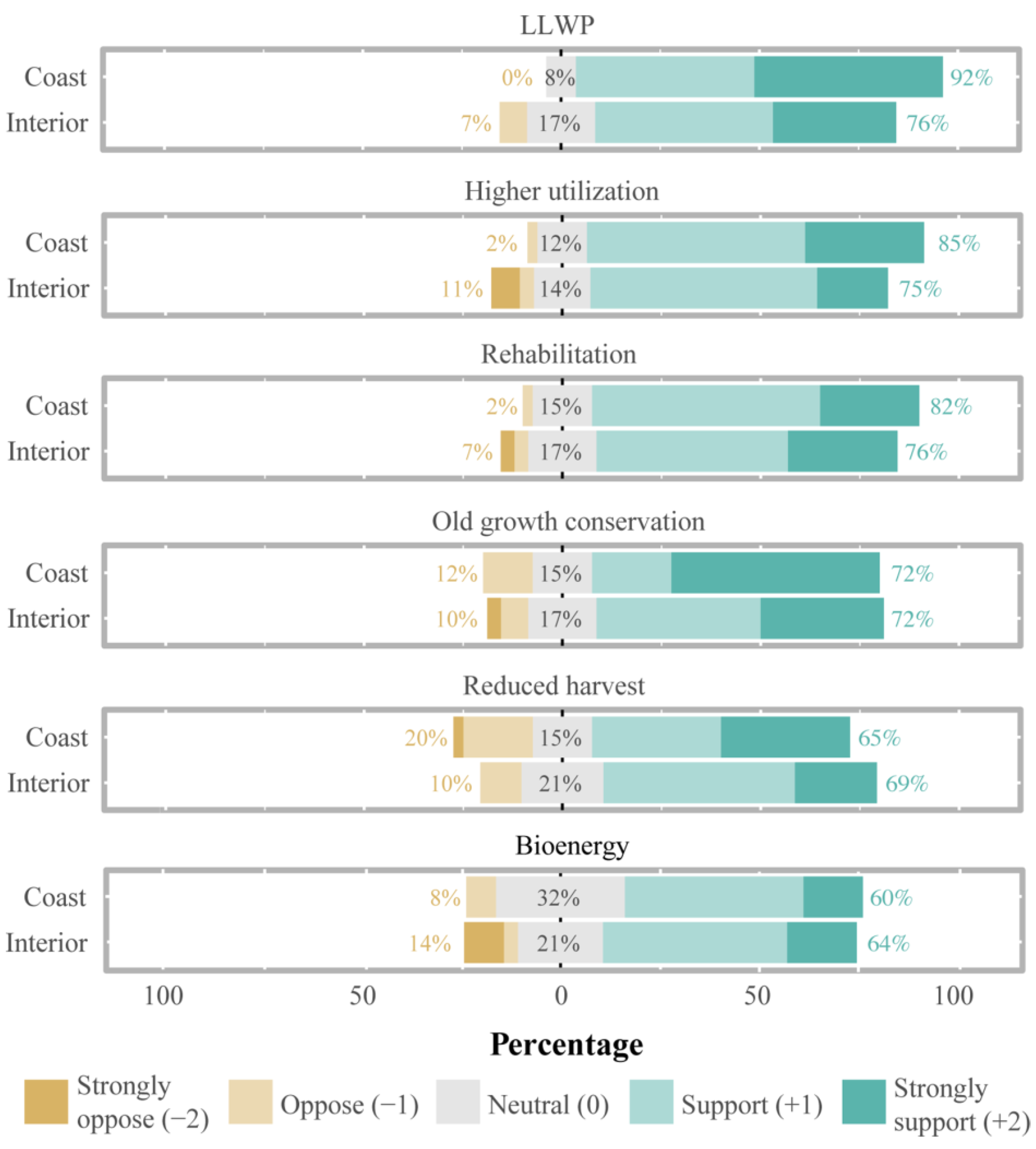
| Strategy | Description |
|---|---|
| Bioenergy | A recovery of a portion of harvest residues for local bioenergy production to replace fossil fuels. |
| A reduction of on-site burning of harvest residues (pile-burning of slash). | |
| Higher Utilization | Higher utilization of wood from harvest cut blocks so that more wood is extracted per hectare, thereby lowering the area harvested while keeping the harvest volume unchanged. |
| Increased proportion of salvage harvesting, referring to the harvesting of trees in forests affected by natural disturbances such as fire and insects, to replace green tree harvesting. | |
| Longer-lived wood products (LLWP) | The production of a commodity mix shifted towards a greater proportion of longer-lived products (sawnwood, other solid wood, and panels), at the expense of pulp and paper products. Both the baseline harvest volume and the proportion exported for each product are assumed to remain unchanged. |
| Reduced harvest | A reduction in harvest with a corresponding decrease in production of wood products. |
| Rehabilitation * | The reforestation of underproductive sites where no trees would otherwise be planted. |
| Old growth conservation | Prevent the harvesting of old growth forests, defined as stands older than 250 years old. |
© 2018 by the authors. Licensee MDPI, Basel, Switzerland. This article is an open access article distributed under the terms and conditions of the Creative Commons Attribution (CC BY) license (http://creativecommons.org/licenses/by/4.0/).
Share and Cite
Peterson St-Laurent, G.; Hoberg, G.; Sheppard, S.R.J. A Participatory Approach to Evaluating Strategies for Forest Carbon Mitigation in British Columbia. Forests 2018, 9, 225. https://doi.org/10.3390/f9040225
Peterson St-Laurent G, Hoberg G, Sheppard SRJ. A Participatory Approach to Evaluating Strategies for Forest Carbon Mitigation in British Columbia. Forests. 2018; 9(4):225. https://doi.org/10.3390/f9040225
Chicago/Turabian StylePeterson St-Laurent, Guillaume, George Hoberg, and Stephen R. J. Sheppard. 2018. "A Participatory Approach to Evaluating Strategies for Forest Carbon Mitigation in British Columbia" Forests 9, no. 4: 225. https://doi.org/10.3390/f9040225





